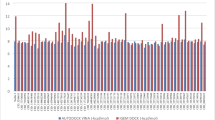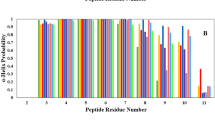Abstract
Tumor suppressor protein p53 maintains integrity of genome and regulates the genes responsible for DNA repair mechanism, apoptosis as well as cell cycle and growth arrest. As with murine double minute 2 (MDM2), the human homolog HDM2 is a principal cellular antagonist of p53. In unstressed cells, cellular levels of p53 and HDM2 are maintained in an autoregulatory manner in which both mutually control cellular levels of each other. About half of the human cancers express wild-type p53 protein that is antagonized by over-expressed HDM2. Restoring p53 function via HDM2 antagonists is a leading therapeutic approach for treating a variety of tumors. In this study, we have developed a novel statistically sound group-based QSAR (GQSAR) model using piperidine-derived compounds that have been validated experimentally to inhibit p53–HDM2 interaction. On the basis of developed GQSAR model, a combinatorial library of molecules was prepared and its activity was predicted. These molecules were then docked to HDM2, and two top-scoring molecules possessing a binding energy of −6.639 and −6.305 kcal/mol were selected for further study. These molecules and their binding poses were analyzed further via molecular dynamic simulations. In this study, we report two lead compounds as potent HDM2 inhibitors and also provide an insight into mechanism of interaction of the lead compounds to HDM2 target.







Similar content being viewed by others
References
Boyle P, Levin B (2008) World cancer report 2008. IARC Press, Intl Agency Res Cancer, Lyon
Cancer IAfRo (2012) World cancer fact sheet. World Health Organization, Geneva
Wade M, Li Y-C, Wahl GM (2013) MDM2, MDMX and p53 in oncogenesis and cancer therapy. Nat Rev Cancer 13(2):83–96
Manfredi JJ (2010) The Mdm2–p53 relationship evolves: Mdm2 swings both ways as an oncogene and a tumor suppressor. Genes Dev 24(15):1580–1589
Candeias MM, Malbert-Colas L, Powell DJ, Daskalogianni C, Maslon MM, Naski N, Bourougaa K, Calvo F, Fåhraeus R (2008) P53 mRNA controls p53 activity by managing Mdm2 functions. Nat Cell Biol 10(9):1098–1105
Goyal S, Grover S, Dhanjal JK, Tyagi C, Goyal M, Grover A (2014) Group-based QSAR and molecular dynamics mechanistic analysis revealing the mode of action of novel piperidinone derived protein–protein inhibitors of p53–MDM2. J Mol Graph Model 51:64–72
Kruse J-P, Gu W (2009) Modes of p53 regulation. Cell 137(4):609–622
Marine J-C, Lozano G (2010) Mdm2-mediated ubiquitylation: p53 and beyond. Cell Death Differ 17(1):93–102
Wade M, Wang YV, Wahl GM (2010) The p53 orchestra: Mdm2 and Mdmx set the tone. Trends Cell Biol 20(5):299–309
Verma J, Khedkar VM, Coutinho EC (2010) 3D-QSAR in drug design—a review. Curr Topics Med Chem 10(1):95–115
Ajmani S, Jadhav K, Kulkarni SA (2009) Group-based QSAR (G-QSAR): mitigating interpretation challenges in QSAR. QSAR Comb Sci 28(1):36–51
Deshpande SK (2008) Molecule fragmentation scheme and method for designing new molecules. Google Patents
Wang F, Li Y, Ma Z, Wang X, Wang Y (2012) Structural determinants of benzodiazepinedione/peptide-based p53–HDM2 inhibitors using 3D-QSAR, docking and molecular dynamics. J Mol Model 18(1):295–306
Ding K, Lu Y, Nikolovska-Coleska Z, Qiu S, Ding Y, Gao W, Stuckey J, Krajewski K, Roller PP, Tomita Y (2005) Structure-based design of potent non-peptide MDM2 inhibitors. J Am Chem Soc 127(29):10130–10131
Lu Y, Nikolovska-Coleska Z, Fang X, Gao W, Shangary S, Qiu S, Qin D, Wang S (2006) Discovery of a nanomolar inhibitor of the human murine double minute 2 (MDM2)–p53 interaction through an integrated, virtual database screening strategy. J Med Chem 49(13):3759–3762
Parks DJ, LaFrance LV, Calvo RR, Milkiewicz KL, Gupta V, Lattanze J, Ramachandren K, Carver TE, Petrella EC, Cummings MD (2005) 1,4-Benzodiazepine-2,5-diones as small molecule antagonists of the HDM2–p53 interaction: discovery and SAR. Bioorg Med Chem Lett 15(3):765–770
Vassilev LT (2004) Small-molecule antagonists of p53–MDM2 binding: research tools and potential therapeutics. Cell Cycle 3(4):417–419
LaRusch GA, Jackson MW, Dunbar JD, Warren RS, Donner DB, Mayo LD (2007) Nutlin3 blocks vascular endothelial growth factor induction by preventing the interaction between hypoxia inducible factor 1α and Hdm2. Cancer Res 67(2):450–454
Tovar C, Rosinski J, Filipovic Z, Higgins B, Kolinsky K, Hilton H, Zhao X, Vu BT, Qing W, Packman K (2006) Small-molecule MDM2 antagonists reveal aberrant p53 signaling in cancer: implications for therapy. Proc Natl Acad Sci USA 103(6):1888–1893
Chen L, Yin H, Farooqi B, Sebti S, Hamilton AD, Chen J (2005) p53 α-Helix mimetics antagonize p53/MDM2 interaction and activate p53. Mol Cancer Therap 4(6):1019–1025
Stoll R, Renner C, Hansen S, Palme S, Klein C, Belling A, Zeslawski W, Kamionka M, Rehm T, Mühlhahn P (2001) Chalcone derivatives antagonize interactions between the human oncoprotein MDM2 and p53. Biochem 40(2):336–344
Zhao J, Wang M, Chen J, Luo A, Wang X, Wu M, Yin D, Liu Z (2002) The initial evaluation of non-peptidic small-molecule HDM2 inhibitors based on p53–HDM2 complex structure. Cancer Lett 183(1):69–77
Luke R, Hudson K, Hayward C, Fielding C, Cotton R, Best R, Giles M, Veldma M, Griffiths L, Breeze A (1999) Design and synthesis of small molecule inhibitors of the MDM2–p53 interaction as potential anti-tumor agents. In Proc Am Assoc Cancer Res, p 4099
Pan W, Lahue BR, Ma Y, Nair LG, Shipps GW, Wang Y, Doll R, Bogen SL (2014) Core modification of substituted piperidines as Novel inhibitors of HDM2–p53 protein–protein interaction. Bioorg Med Chem Lett 24(8):1983–1986
Hardcastle IR, Ahmed SU, Atkins H, Farnie G, Golding BT, Griffin RJ, Guyenne S, Hutton C, Källblad P, Kemp SJ (2006) Small-molecule inhibitors of the MDM2–p53 protein–protein interaction based on an isoindolinone scaffold. J Med Chem 49(21):6209–6221
Dai Y, Chen N, Wang Q, Zheng H, Zhang X, Jia S, Dong L, Feng D (2012) Docking analysis and multidimensional hybrid QSAR model of 1,4-benzodiazepine-2,5-diones as HDM2 antagonists. Iran J Pharm Res (IJPR) 11(3):807
Mondal C, Halder AK, Adhikari N, Saha A, Saha KD, Gayen S, Jha T (2015) Comparative validated molecular modeling of p53–HDM2 inhibitors as antiproliferative agents. Eur J Med Chem 90:860–875
Dong X, Yan J, Lu D, Wu P, Gao J, Liu T, Yang B, Hu Y (2012) QSAR models for isoindolinone-based p53–MDM2 interaction inhibitors using linear and non-linear statistical methods. Chem Biol Drug Des 79(5):691–702
Hu C, Dou X, Wu Y, Zhang L, Hu Y (2012) Design, synthesis and CoMFA studies of N1-amino acid substituted 2,4,5-triphenyl imidazoline derivatives as p53–MDM2 binding inhibitors. Bioorg Med Chem 20(4):1417–1424
Bo L, Rui Z, Gu H, Li G, Wei H (2013) Molecular docking, QSAR and molecular dynamics simulation on spiro-oxindoles as MDM2 inhibitors. Acta Chim Sin 71(10):1396–1403
Hu C, Hu Y (2012) 3D-QSAR studies on isoquinolinone derivatives as inhibitors of p53–MDM2 Binding. 2012 长三角药物化学研讨会论文集
Ma Y, Lahue BR, Shipps GW, Brookes J, Wang Y (2014) Substituted piperidines as HDM2 inhibitors. Bioorg Med Chem Lett 24(4):1026–1030
Tyagi C, Gupta A, Goyal S, Dhanjal JK, Grover A (2014) Fragment based group QSAR and molecular dynamics mechanistic studies on arylthioindole derivatives targeting the α-β interfacial site of human tubulin. BMC Genom 15(Suppl 9):S3
Csizmadia P (1999) MarvinSketch and MarvinView: molecule applets for the World Wide Web. In: Proceedings of ECSOC-3, the third international electronic conference on synthetic organic chemistry, 1–30 Sept 1999, pp 367–369
Vlife M (2008) Software package, version 3.0, supplied by Vlifescience technologies Pvt. Ltd, Pune
Wold S, Sjöström M, Eriksson L (2001) PLS-regression: a basic tool of chemometrics. Chemom Intell Lab Syst 58(2):109–130
Goyal S, Dhanjal JK, Tyagi C, Goyal M, Grover A (2014) Novel fragment-based QSAR modeling and combinatorial design of pyrazole-derived CRK3 inhibitors as potent antileishmanials. Chem Biol Drug Des 84(1):54–62
Dhanjal JK, Goyal S, Sharma S, Hamid R, Grover A (2014) Mechanistic insights into mode of action of potent natural antagonists of BACE-1 for checking Alzheimer’s plaque pathology. Biochem Biophys Res Commun 443(3):1054–1059
Vats C, Dhanjal JK, Goyal S, Bharadvaja N, Grover A (2014) Computational design of novel flavonoid analogues as potential AChE inhibitors: analysis using group-based QSAR, molecular docking and molecular dynamics simulations. Struct Chem 26(2):1–10
Patel K, Tyagi C, Goyal S, Dhanjal JK, Bharadvaja N, Grover A (2014) Curcumin-based IKKβ inhibiting anticancer lead design using novel fragment-based group QSAR modelling. Med Chem Res 24(5):1–11
Rücker C, Rücker G, Meringer M (2007) y-Randomization and its variants in QSPR/QSAR. J Chem Inf Model 47(6):2345–2357
Rücker C, Rücker G, Meringer M (2007) Y-Randomization—a useful tool in QSAR validation, or folklore? J Chem Inf Model 47(6):2345–2357
Fasan R, Dias RL, Moehle K, Zerbe O, Obrecht D, Mittl PR, Grütter MG, Robinson JA (2006) Structure-activity studies in a family of β-hairpin protein epitope mimetic inhibitors of the p53–HDM2 protein–protein interaction. ChemBioChem 7(3):515–526
Schrödinger L (2009) Schrödinger suite 2009. Maestro version 9. New York, NY
Grover S, Dhanjal JK, Goyal S, Grover A, Sundar D (2014) Computational identification of novel natural inhibitors of glucagon receptor for checking type II diabetes mellitus. BMC Bioinf 15(Suppl 16):S13
Dhanjal JK, Grover S, Paruthi P, Sharma S, Grover A (2014) Mechanistic insights into mode of action of a potent natural antagonist of orexin receptor-1 by means of high throughput screening and molecular dynamics simulations. Comb Chem High Throughput Screen 17(2):124–131
Sastry GM, Adzhigirey M, Day T, Annabhimoju R, Sherman W (2013) Protein and ligand preparation: parameters, protocols, and influence on virtual screening enrichments. J Comput Aided Mol Des 27(3):221–234
Friesner RA, Murphy RB, Repasky MP, Frye LL, Greenwood JR, Halgren TA, Sanschagrin PC, Mainz DT (2006) Extra precision glide: docking and scoring incorporating a model of hydrophobic enclosure for protein–ligand complexes. J Med Chem 49(21):6177–6196
Shivakumar D, Williams J, Wu Y, Damm W, Shelley J, Sherman W (2010) Prediction of absolute solvation free energies using molecular dynamics free energy perturbation and the OPLS force field. J Chem Theory Comput 6(5):1509–1519
Wildman SA, Crippen GM (1999) Prediction of physicochemical parameters by atomic contributions. J Chem Inf Comput Sci 39(5):868–873
Jhala DD, Chettiar SS, Singh JK (2012) Optimization and validation of an in vitro blood brain barrier permeability assay using artificial lipid membrane. J Bioequiv Availab S14:009. doi:10.4172/jbb.S14-009
Gonzalez AZ, Li Z, Beck HP, Canon J, Chen A, Chow D, Duquette J, Eksterowicz J, Fox BM, Fu J (2014) Novel inhibitors of the MDM2–p53 interaction featuring hydrogen bond acceptors as carboxylic acid isosteres. J Med Chem 57(7):2963–2988
Cheng F, Li W, Zhou Y, Shen J, Wu Z, Liu G, Lee PW, Tang Y (2012) admetSAR: a comprehensive source and free tool for assessment of chemical ADMET properties. J Chem Inf Model 52(11):3099–3105
Acknowledgments
AG is thankful to Jawaharlal Nehru University for usage of all computational facilities. AG is grateful to University Grants Commission, India, for the Faculty Recharge Position.
Authors’ contributions
AS, SG, SJ and AG designed the methods and experimental setup. AS, SG and SJ carried out the implementation of various methods and were assisted by BS, MD and NA. AS, SG, SJ and AG wrote the manuscript.
Author information
Authors and Affiliations
Corresponding author
Ethics declarations
Conflict of interest
The authors declare that they have no competing interests.
Electronic supplementary material
Below is the link to the electronic supplementary material.
Rights and permissions
About this article
Cite this article
Singh, A., Goyal, S., Jamal, S. et al. Computational identification of novel piperidine derivatives as potential HDM2 inhibitors designed by fragment-based QSAR, molecular docking and molecular dynamics simulations. Struct Chem 27, 993–1003 (2016). https://doi.org/10.1007/s11224-015-0697-2
Received:
Accepted:
Published:
Issue Date:
DOI: https://doi.org/10.1007/s11224-015-0697-2




